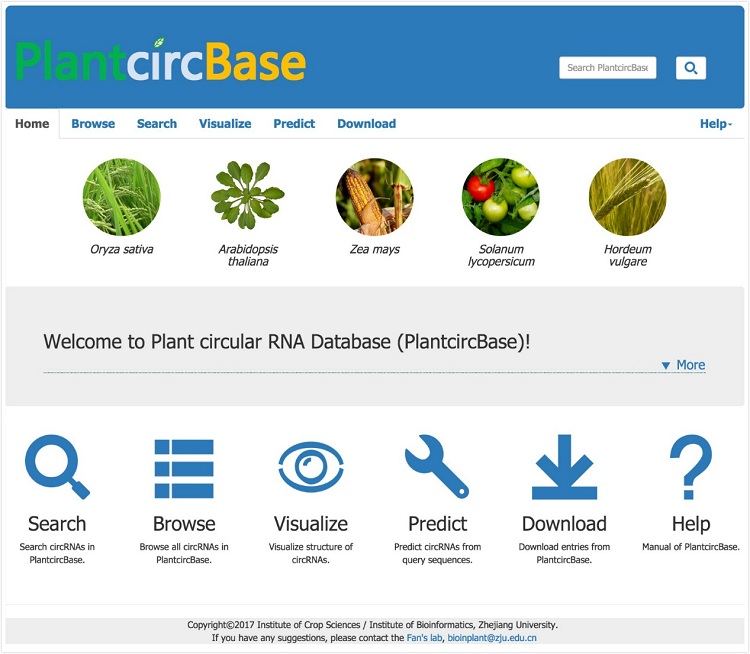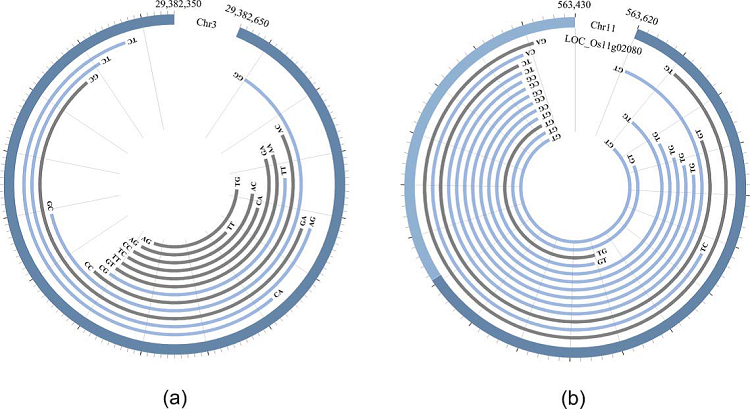The latest research result of Prof. Fan Longjiang group, which is titled “PlantcircBase: a database for plant circular RNAs”, has been published on line by Molecular Plant 0(5 year impact factor=6.885), article linkage: http://www.cell.com/molecular-plant/fulltext/S1674-2052(17)30074-6). This is the first plant circRNA database in the world, which includes a total of 77,595 unique circRNAs from diverse organisms as well as circRNA-miRNA-mRNA interaction information and tools for visualizing structures of circRNAs and predicting circRNAs. The research group of Prof. Fan Longjiang has made a series of achievements in the field of plant circRNAs in the recent three years, which were published on publications such as Bioinformatics, New Phytologist and RNA Biology.

Figure 1 Homepage of PlanrcircBase (http://ibi.zju.edu.cn/plantcircbase/)
Circular RNAs (circRNAs) are covalently closed loops derived from back-splicing of precursor mRNAs. Recently, a large number of circRNAs have been detected among diverse organisms. However, there is very little research results in the field of plant circRNAs.
Prof. Fan Longjiang group has combined the professional advantages of bioinformatics and crop science, and achieved a series of research results: (1) For the first time in plants, they identified 12,037 and 6,012 circRNAs in Oryza sativa and Arabidopsis thaliana, respectively, with 56% (10/18) of the sampled rice exonic circRNAs validated experimentally. They demonstrated that circRNAs are widespread in plants and revealed the common and distinct features of circRNAs between plants and animals (Ye et al., 2015, New Phytologist). (2) a software for prediction of plant circRNAs, termed PcircRNA_finder (Chen et al., 2016, Bioinformatics), was developed, which is more sensitive and precise in detecting plant circRNAs than other frequently used programs, such as find_circ and CIRCexplorer, by analyzing simulated and real rRNA-depleted/RNase R-treated RNA-Seq data from A. thaliana and O. sativa. (3) Another software, termedcircseq-cup (Ye et al., 2016, RNA Biology), was also developed, which can assemble the full-length sequences of circRNAs using the back-splicing RNA-Seq reads and their corresponding paired-end reads. They for the first time identified full-length sequences of nearly 3,000 circRNAs in O. sativa by applying “circseq-cup” to an rRNA-depleted/RNase R-treated RNA-Seq dataset. They further showed that alternative circularization of circRNA is a common feature in O. sativa and, surprisingly, found that the junction sites of a large number of circRNAs are flanked by diverse non-GT/AG splicing signals in O. sativa while most human exonic circRNAs are flanked by canonical GT/AG splicing signals. Moreover, Prof. Fan Longjiang group have created a database (PlantcircBase, http://ibi.zju.edu.cn/plantcircbase/) (Chu et al., 2017, Molecular Plant) of plant circRNAs. They have collected publicly available circRNAs identified in recent years by bioinformatics prediction and/or experimental validation, as well as circRNAs newly identified by their own lab. Totally, PlantcircBase includes 40,314, 35,884, 496, 854 and 47 unique circRNAs in O. sativa, A. thaliana, Zea mays, Solanum lycopersicum and Hordeum vulgare, respectively. Apart from the detailed and comprehensive information for each circRNA entry, PlantcircBase also provides basic tools including browsing, searching and downloading as well as advanced tools, including visualizing structures of circRNAs and predicting circRNAs.

Figure 2 Alternative circularization at the circRNA locus of the rice genome
This work was supported by the National Science Foundation of China (91435111), the National Basic Research Program of China (2015CB150200), Shanghai Municipal Commission of Agriculture (2014-7-1-4), and Jiangsu Collaborative Innovation Center for Modern Crop Production (JCIC-MCP).
References:
(1) Ye Chuyu, Chen Li, Liu Chen, Zhu Qian-Hao, Fan Longjiang. Widespread non-coding circular RNAs in plants. New Phytologist, 2015.(http://onlinelibrary.wiley.com/doi/10.1111/nph.13585/abstract)
(2) Chen Li, Yu Yongyi, Zhang Xingchen, Liu Chen, Ye Chuyu, Fan Longjiang. PcircRNA_finder: a software for circRNA prediction in plants. Bioinformatics, 2016.(https://www.ncbi.nlm.nih.gov/pubmed/?term=27493192)
(3) Ye Chuyu, Zhang Xingchen, Chu Qinjie, Liu Chen, Yu Yongyi, Jiang Weiqin, Zhu Qian-Hao, Fan Longjiang, GuoLongbiao. Full length sequence assembly reveals circular RNAs with diverse non GT/AG splicing signals in rice. RNA Biology, 2016.(https://www.ncbi.nlm.nih.gov/pubmed/?term=27739910)
(4) Chu Qinjie, Zhang Xingchen, Zhu Xintian, Liu Chen, Mao Lingfeng, Ye Chuyu, Zhu Qian-Hao, Fan Longjiang. PlantcircBase: a database for plant circular RNAs. Molecular Plant, 2017.(http://www.cell.com/molecular-plant/fulltext/S1674-2052(17)30074-6)